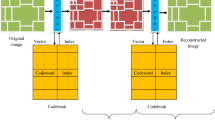Abstract
In the field of data compression, the performance of an image compression technique based on the amount of compression ratio achieved keeps the visual quality of the decompressed image as close to the original as possible. In conventional vector quantization techniques, the size of the code vector plays an important role in measuring the amount of space required to store an image. The compression ratio of the method decreases as the size of the code vector increases. The current study proposes a new image compression technique that generates a common code vector for a number of images of the same or different sizes by adjusting some tuning parameters. This common code vector holds a unique code word for each and every image. At the same time, index matrices are updated according to the index value of the common code vector. The images are decompressed using the respective index matrix and the common code vector. So, in this work, for the same or different sizes of images, only one common code vector is generated. The size of the common code vector is much less compared to the total size of the individual code vectors. Hence, it achieves a very high compression ratio. The proposed method is applied to many standard images found in literature and images from the UCIDv.2 color image database. Experimental results are analyzed in terms of peak signal to noise ratio (PSNR), structure similarity index parameter (SSIM), and compression ratio. The experimental result shows that the proposed method achieved an average of 95.12% compression ratio, which is 3.51% higher than the conventional vector quantization algorithm and 7.42% higher than the existing modified vector quantization technique, keeping the visual quality of the decompressed image almost the same as those two image compression algorithms.







Similar content being viewed by others
References
Gonzalez RC, Woods RE, Eddins SL. Digital image processing using MATLB. Mc-Graw Hill; 2011.
Gan G, Ma C, Wu J. Data clustering theory, algorithms and applications. SIAM; 2007.
Jain AK, Dubes RC. Algorithms for clustering data. Prentice-Hall; 2004.
Kil DH, Shin FB. Reduced dimension image compression and its applications. In: Proc. of Int. Conference Image Processing 3, 1995; pp. 500–503.
Li CK, Yuen H. A high-performance image compression technique for multimedia applications. IEEE Trans Consum Electron. 1996;42(2):239–43.
Barman D, Hasnat A, Barman B. An enhanced technique to improve the performance of multi-image compression technique. In: Advanced computing and intelligent technologies. Springer; 2022. https://doi.org/10.1007/978-981-19-2980-9_25.
Hasnat A, Barman D, Barman B. Luminance approximated vector quantization algorithm to retain better image quality of the decompressed image. Multimed Tools Appl. 2021;80(11985):12007. https://doi.org/10.1007/s11042-020-10403-9.
Hasnat A, Barman D. A proposed multi-image compression technique. J Intell Fuzzy Syst. 2019;36(4):3177–93. https://doi.org/10.3233/JIFS-18360.
Avcibas I, Memon N, Sayood K. A progressive lossless/near lossless image compression algorithm. IEEE Signal Process Lett. 2002;9(10):312–4.
Hussain AJ, Fayadh AA, Radi N. Image compression techniques: a survey in lossless and lossy algorithm. Neurocomputing. 2018;300:44–69. https://doi.org/10.1016/j.neucom.2018.02.094.
Kim S, Cho NI. A lossless color image compression method based on a new reversible color transform. In: Proc. of IEEE Int. Conference on Visual Communications and Image Processing 2012. https://doi.org/10.1109/VCIP.2012.6410808.
Linde Y, Buzo A, Gray RM. An algorithm for vector quantizer design. IEEE Trans Commun COM. 1980;28(1):84–195.
Gray RM. Vector quantization. IEEE ASSP Mag. 1984;1(2):4–29.
Wenhua L, Salari E. A fast vector quantization encoding method for image compression. IEEE Trans Circuits Syst Video Technol. 1995;5(2):119–223. https://doi.org/10.1109/76.388060.
Thepade SD, Mhaske V, Kurhade V. New Clustering Algorithm for Vector Quantization using Slant Transform. In: ICETACS, St. Anthony's College, Shillong, India, 2013. https://doi.org/10.1109/ICETACS.2013.6691415.
Mahapatra DK, Jena UR. Partitional K-means clustering based hybrid DCT-vector quantization for image compression. In: IEEE Conference on ICT, Noorul Islam University Thuckalay, Tamil Nadu, India, 2013. https://doi.org/10.1109/CICT.2013.6558278.
Leitao HAS, Lopes WTA, Madeiro F. PSO algorithm applied to codebook design for channel-optimized vector quantization. IEEE Lat Am Trans. 2015;13(4):961–7. https://doi.org/10.1109/TLA.2015.7106343.
Hasnat A, Barman D, Halder S, Bhattacharjee D. Modified vector quantization algorithm to overcome the blocking artefact problem of vector quantization algorithm. IOSP. 2017;32(5):3711–27. https://doi.org/10.3233/JIFS-169304.
Rajini H. Efficient image compression technique based on vector quantization using social spider optimization algorithm. Int J Innov Technol Explor Eng. 2019;8(7):359–66 (G5259058719/19©BEIESP).
Wu MT. Efficient reduction of artifact effect based on power and entropy measures. In: IEEE Int. Conference on Fuzzy System and Knowledge Discovery (FSKD), 2015. https://doi.org/10.1109/FSKD.2015.7382241.
Charrier C, Knoblauch K, Maloney LT, Bovik AC, Moorthy AK. Optimizing multiscale SSIM for compression via mlds. IEEE Trans Image Process. 2012;21(12):4682–94. https://doi.org/10.1109/TIP.2012.2210723.
Saad MA, Bovik AC, Charrier C. Blind image quality assessment: a natural scene statistics approach in the dct domain. IEEE Trans Image Process. 2012;21(8):3339–52. https://doi.org/10.1109/TIP.2012.2191563.
Al-Najjar YAY, Soong DC. Comparison of image quality assessment: PSNR, HVS, SSIM, UIQI. Int J Sci Eng Res. 2012;3(8):1–5.
Sara U, Akter M, Uddin MS. Image quality assessment through FSIM, SSIM, MSE and PSNR—a comparative study. J Comp Commun. 2019;7(3):8–18. https://doi.org/10.4236/jcc.2019.73002.
Mandal JK. Reversible steganography and authentication via transform encoding. Springer; 2020. (ISBN: 9789811543975).
Funding
This research receives no specific grant from any funding agency in the public, commercial, or not-for-profit sector.
Author information
Authors and Affiliations
Corresponding author
Ethics declarations
Conflict of interest
The authors declare that there is no conflict of interest.
Additional information
Publisher's Note
Springer Nature remains neutral with regard to jurisdictional claims in published maps and institutional affiliations.
Rights and permissions
Springer Nature or its licensor (e.g. a society or other partner) holds exclusive rights to this article under a publishing agreement with the author(s) or other rightsholder(s); author self-archiving of the accepted manuscript version of this article is solely governed by the terms of such publishing agreement and applicable law.
About this article
Cite this article
Barman, D., Hasnat, A. & Barman, B. Development of Multi-Image Compression Technique Based on Common Code Vector. SN COMPUT. SCI. 4, 31 (2023). https://doi.org/10.1007/s42979-022-01450-0
Received:
Accepted:
Published:
DOI: https://doi.org/10.1007/s42979-022-01450-0




